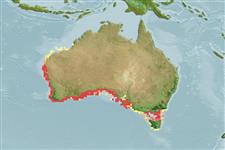Preferred temperature (Ref.
123201): 15.7 - 23.8, mean 18 °C (based on 215 cells).
Phylogenetic diversity index (Ref.
82804): PD
50 = 0.5000 [Uniqueness, from 0.5 = low to 2.0 = high].
Bayesian length-weight: a=0.00457 (0.00230 - 0.00908), b=3.09 (2.91 - 3.27), in cm total length, based on LWR estimates for this (Sub)family-body shape (Ref.
93245).
Trophic level (Ref.
69278): 4.0 ±0.4 se; based on diet studies.
Generation time: 3.3 (2.5 - 4.4) years. Estimated as median ln(3)/K based on 11
growth studies.
Resilience (Ref.
120179): Medium, minimum population doubling time 1.4 - 4.4 years (tm=1-2; tmax=12).
Fishing Vulnerability (Ref.
59153): Low to moderate vulnerability (35 of 100).
Nutrients (Ref.
124155): Calcium = 129 [10, 478] mg/100g; Iron = 1.84 [0.49, 4.79] mg/100g; Protein = 18.4 [16.1, 20.6] %; Omega3 = 0.299 [0.133, 0.836] g/100g; Selenium = 46.7 [12.9, 165.9] μg/100g; VitaminA = 7.74 [3.19, 18.47] μg/100g; Zinc = 0.841 [0.391, 1.706] mg/100g (wet weight);
